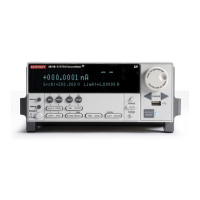2600S-901-01 Rev. C / January 2008 Return to Section Topics 2-39
Series 2600 System SourceMeter® Instruments Reference Manual Section 2: TSP Programming
NOTE The loadandrunscript name command sets the
autorun attribute for that script to “yes.” To cancel autorun, set the
autorun attribute to “no” and save the script.
Autoexec script
One script can be designated as the autoexec script. When the Series 2600 is turned on, the
autoexec script will start after all the autorun scripts have run.
loadscript autoexec
loadandrunscript autoexec
An autoexec script can be formed by creating a new script and naming it autoexec (as shown
above using
loadscript or loadandrunscript). After loading the new script, send the
autoexec.save() command to save it in non-volatile memory. See “Creating a user script”
(described earlier in this section) for details on creating a script.
An autoexec script can also be created by changing the name of an existing script that is saved in
non-volatile memory by using the following command:
myscript.save("autoexec")
where: myscript is the user-defined name of the script.
Example:
Assume a script named “test6” is saved in non-volatile memory. That script can be made into an
autoexec script as follows:
test6.save("autoexec")
The next time the Series 2600 is turned on, the “test6” script will automatically load and start after
all of the autorun scripts have run.
Running a user script from the Series 2600 front panel controls
In order to run a user script from the front panel, an entry for the script needs to be added to the
User menu for the LOAD key. The following commands are used to enter or delete a name into the
User menu:
display.loadmenu.add(displayname, script)
display.loadmenu.delete(displayname)
where: displayname is the name to be added to (or deleted from) the User menu.
script is the name of the script.
It does not matter what order the items are added to the User menu. Menu items will be displayed
in alphabetical order when the menu is selected.
Example:
Assume a user script named “Test9” has been loaded into the run-time environment. Add the
name (“Test9”) to the User menu for the script as follows:
display.loadmenu.add(Test9, Test9)

